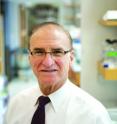Joslin researchers identify new target for treatment of type 2 diabetes and prediabetes
Researchers at the Joslin Diabetes Center have shown that an enzyme found in the mitochondria of cells is decreased in the skeletal muscle of those with diabetes, a finding that could lead to the development of drugs to boost the activity of this enzyme in an effort to fight the disease. A paper in published online in the Proceedings of the National Academy of Sciences, showed that the enzyme, Sirt3, is decreased in the skeletal muscle of humans and animals with diabetes by at least half, compared to those without diabetes and that this may contribute to development of insulin resistance, one of the earliest manifestations of the disease. Sirt3 is found in the mitochondria, the power producers of cells that convert energy into usable forms.
"Ours is perhaps the first study to understand what is going wrong in the mitochondria of those with diabetes," said senior author C. Ronald Kahn, M.D., Head of the Joslin Section on Integrative Physiology and Metabolism and the Mary K. Iacocca Professor of Medicine at Harvard Medical School. "Many studies have shown that the mitochondria don't work well in those with diabetes. This points to a cause of why they don't work well."
Dr. Kahn said the study sought to look at how decreased Sirt3 levels might affect the metabolism of cells, particularly how it could affect insulin action in cells. "We know that one of the hallmarks of early diabetes is insulin resistance in muscle, but we didn't know what caused it," he said.
He said the study showed that when Sirt3 levels are low, as they are in the case of diabetes, the mitochondria of the cells are not as efficient in energy metabolism as they should be.
When the mitochondria become inefficient, they generate what are known as reactive oxygen species (ROS), chemically reactive molecules containing oxygen, which create insulin resistance in the muscles, he said.
"This is the first time this has been shown," Dr. Kahn said.
The goal for the future will be to find ways to restore levels of Sirt3 or increase the activity of the existing Sirt3, perhaps with a drug, in a bid to improve insulin resistance in the muscle and improve muscle metabolism, he said.
"It is a new target," he said.
Dr. Kahn noted that this study is one of the first demonstrations of a single defect that could affect mitochondrial metabolism and insulin signaling in the muscle.
"In further studies we will try to understand what proteins Sirt3 acts on," he said.
He noted that one of the earliest hallmarks of diabetes is insulin resistance in the skeletal muscle. As a result, a drug to boost Sirt3 levels could be useful in the treatment of prediabetes or in those newly diagnosed with the disease, he said.
"Agents which increase Sirt3 activity could, therefore, potentially reverse at least some of the adverse effects of type 2 diabetes," the paper concludes.
Co-authors included Enxuan Jing, lead author, as well as Brice Emanuelli, Jeremie Boucher and Kevin Lee, all of Joslin; Matthew D. Hirschey and Eric M. Verdin, both of Gladstone Institute of Virology and Immunology and the University of California, San Francisco; and David Lombard, formerly of the Department of Genetics at Harvard Medical School and currently at the Department of Pathology and Institute of Gerontology at the University of Michigan.
Dr. Verdin noted that by "uncovering the multi-faceted role of SIRT3, we are laying important groundwork to better combat this widespread disease at the cellular level."
The study was supported by research grants to Kahn and Verdin as well as a grant from the Ellison Foundation and the Mary K. Iacocca Professorship. The study also received support from the Joslin DERC cores laboratories.
Source: Joslin Diabetes Center
Other sources
- New target for treatment of type 2 diabetes and prediabetes identifiedfrom Science DailyMon, 22 Aug 2011, 21:30:27 UTC
- Researchers identify new target for treatment of type 2 diabetes and prediabetesfrom PhysorgMon, 22 Aug 2011, 19:30:39 UTC
- Researchers Identify New Target for Treatment of Type 2 Diabetes and Prediabetesfrom Newswise - ScinewsMon, 22 Aug 2011, 18:00:36 UTC
